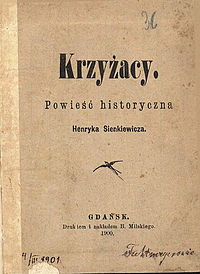


Cover page of the 1900 print
| |
| Author | Henryk Sienkiewicz |
|---|---|
| Original title | Krzyżacy |
| Language | Polish |
| Genre | Historical novel |
| Publisher | Tygodnik Illustrowany (serial) Wł. Anczyc & Co. Press (first novel) |
Publication date | 1900 |
| Publication place | Poland |
| Media type | Print (Hardback & Paperback) |
| ISBN | N/A Parameter error in {{ISBNT}}: invalid character |
| OCLC | 751659 |
The Knights of the CrossorThe Teutonic Knights (Polish: Krzyżacy) is a 1900 historical novel written by the eminent Polish Positivist writer and the 1905 Nobel laureate, Henryk Sienkiewicz. Its first English translation was published in the same year as the original.[1]
The book was serialized by the magazine Tygodnik Illustrowany between 1897–1899 before its first complete printed edition appeared in 1900. The book was first translated into English by Jeremiah Curtin, a contemporary of Henryk Sienkiewicz.[1] The Teutonic Knights had since been translated into 25 languages. It was the first book to be printed in Poland at the end of the Second World War in 1945, due to its relevance in the context of Nazi German destruction of Poland followed by mass population transfers.
The novel was written by Sienkiewicz at the time of the Partitions of Poland between Russian, Austrian and German empires, with the majority of Poles living in the Russian occupation zone named Vistula Land, formerly Congress Poland. One of Sienkiewicz's goals in writing The Knights of the Cross was to encourage and strengthen Polish national confidence against the occupying powers. In order to circumvent the Russian censorship, he placed the plot in the Middle ages, around Prussia (region) and the State of the Teutonic Order.
The history of the German Order of the Teutonic Knights serves as the backdrop for the story. From the 13th century on, the Order controlled large parts of the Baltic Sea coast, until its defeat at the 1410 Battle of Grunwald by the United Kingdom of Poland and Lithuania. The novel focuses extensively on the medieval life and customs of both, the cities and the countryside of Medieval Poland.
In 1960 the novel was made into a Polish film of the same name, by director Aleksander Ford, with Emil Karewicz as King Władysław Jagiełło.

Krzyżacy tells the story of a young nobleman, Zbyszko of Bogdaniec, who together with his uncle Maćko of Bogdaniec returns from the war against the Order (Knights of the Cross) in nearby Lithuania. In a tavern inn Zbyszko falls in love with the lovely Danusia, who is traveling with the court of the Duchess Anna. He swears to her his knight's oath and promises to bring her "three trophies" from the Teutonic Knights.
On his way to the royal city of Kraków (Cracow), Zbyszko attacks Kuno von Liechtenstein, who is an official diplomatic delegate of the Teutonic Knights. The penalty is death. Yet, on the gallows, Danusia saves him from execution when she jumps onto the platform in full view of the crowd, and promises to marry him, covering his head with her handkerchief (an old Polish tradition that carries with it a stay of execution if the couple wed). Zbyszko and Maćko return home to their estate, where they rebuild their mansion. After some time Zbyszek returns to Danuśka and marries her. However, she is soon treacherously kidnapped by four Teutonic Knights who want revenge – her father Jurand fought against the Germans. Jurand himself is soon captured by them, imprisoned and cruelly tortured and maimed.
Zbyszko's quest to find and save his kidnapped Danusia continues until, at long last, he rescues her. However, it is too late already. Danuta has been driven insane because of her treatment at the hands of her captors, and eventually dies. The long awaited war begins. The combined forces of Poland and Lithuania under the command of Polish King Ladislaus Jagiello destroy the Teutonic Order in the monumental 1410 Battle of Grunwald. This battle signals the true terminal decline of the Teutonic Order.